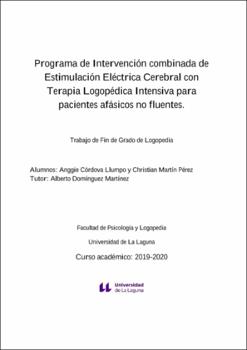Programa de Intervención combinada de Estimulación Eléctrica Cerebral con Terapia Logopédica Intensiva para pacientes afásicos no fluentes.
Fecha
2020Resumen
El síndrome afásico es una secuela causada, en la mayoría de los casos, por ACV
isquémicos que tiene repercusiones significativas sobre los diferentes ámbitos lingüísticos
de la persona. El daño cerebral ocasionado se modula a través de una respuesta natural del
órgano, conocida como plasticidad cerebral, según la cual las funciones afectadas por la
lesión son suplidas por las regiones cerebrales homólogas contralatereales. Esta respuesta,
en principio adaptativa, puede, sin embargo, tener el riesgo de que se modifiquen las
conexiones interhemisféricas, impidiendo en etapas avanzadas del tratamiento una
recuperación de la función en su lugar de origen. La terapia logopédica ocupa un papel
importante en la rehabilitación de pacientes afásicos, además, la estimulación cerebral
ayuda notablemente en la terapia, reestructurando nuevamente la localización de las
funciones lingüísticas en el hemisferio izquierdo. En particular la terapia logopédica que
será usada es intensiva, concretamente Rehabilitación Grupal Intensiva de la Afasia
(REGIA), una versión al español de la terapia americana conocida como ConstraintInduced Aphasia Therapy (CIAT), acompañada de la aplicación en primer lugar de la
Estimulación Transcraneal de corriente Directa (tDCS).
Diferentes investigaciones exponen valoraciones positivas sobre la combinación de ambas
terapias, la Estimulación Eléctrica Cerebral y la Terapia Logopédica o del habla (Yang,
2017).
Palabras clave: afasias no fluid The aphasic syndrome is a consequence in most cases, of ischemic strokes, and it has
significant impact on several linguistic aspects of the person. The brain damage is
modulated through a natural response of the brain, known as plasticity, acording to which
the left affected areas are supplied by the contralateral homologous brain regions. However,
there is a certain risk that interhemispheric connections may be difficult to maintain, thus
preventing recovery in advanced stages of treatment. Speech therapy plays an important
role in the rehabilitation of aphasic patients. Moreover, brain stimulation helps significantly
to restructure again the location of language functions in their respective places. In
2
particular the speech therapy that will be used is intensive, namely Rehabilitación Grupal
Intensiva de la Afasia (REGIA), a Spanish version of the american therapy known as
Constraint-Induced Aphasia Therapy (CIAT), This therapy will be preceded by the
application of Transcranial Direct Current Stimulation (tDCS).
Different studies show positive evaluations about the combination of these two therapies,
Electric Brain Stimulation and Speech Therapy (Yang, 2017).





